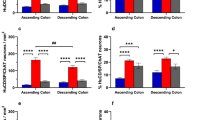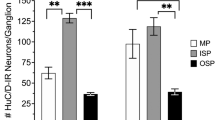Abstract
In this study, we characterized human myenteric neurons co-immunoreactive for neuronal nitric oxide synthase (nNOS) and vasoactive intestinal peptide (VIP) by their morphology and their proportion as related to the putative entire myenteric neuronal population. Nine wholemounts (small and large intestinal samples) from nine patients were triple-stained for VIP, neurofilaments (NF) and nNOS. Most neurons immunoreactive for all three markers displayed radially emanating, partly branching dendrites with spiny endings. These neurons were called spiny neurons. The spiny character of their dendrites was more pronounced in the small intestinal specimens and differed markedly from enkephalinergic stubby neurons described earlier. Exclusively in the duodenum, some neurons displayed prominent main dendrites with spiny side branches. Of the axons which could be followed from the ganglion of origin within primary strands of the myenteric plexus beyond the next ganglion (70 out of 140 traced neurons), 94.3% run anally and 5.7% orally. Very few neurons reactive for both VIP and nNOS could not be morphologically classified due to weak or absent NF-immunoreactivity. Another six wholemounts were triple-stained for VIP, nNOS and Hu proteins (HU). The proportion of VIP/nNOS-coreactive neurons in relation to the number of HU-reactive neurons was between 5.8 and 11.5% in the small and between 10.6 and 17.5% in the large intestinal specimens. We conclude that human myenteric spiny neurons co-immunoreactive for VIP and nNOS represent either inhibitory motor or descending interneurons.






Similar content being viewed by others
References
Anlauf M, Schäfer MK-H, Eiden L, Weihe E (2003) Chemical coding of the human gastrointestinal nervous system: cholinergic, VIPergic, and catecholaminergic phenotypes. J Comp Neurol 459:90–111
Belai A, Boulos PB, Robson T, Burnstock G (1997) Neurochemical coding in the small intestine of patients with Crohn’s disease. Gut 40:767–774
Belai A, Burnstock G (1999) Distribution and colocalization of nitric oxide synthase and calretinin in myenteric neurons of developing, aging, and Crohn’s disease human small intestine. Dig Dis Sci 44:1579–1587
Brehmer A, Schrödl F, Neuhuber W (1999) Morphological classifications of enteric neurons—100 years after Dogiel. Anat Embryol 200:125–135
Brehmer A, Blaser B, Seitz G, Schrödl F, Neuhuber W (2004a) Pattern of lipofuscin pigmentation in nitrergic and non-nitrergic, neurofilament immunoreactive myenteric neuron types of human small intestine. Histochem Cell Biol 121:13–20
Brehmer A, Croner R, Dimmler A, Papadopoulos T, Schrödl F, Neuhuber W (2004b) Immunohistochemical characterization of putative primary afferent (sensory) myenteric neurons in human small intestine. Auton Neurosci 112:49–59
Brehmer A, Lindig TM, Schrödl F, Neuhuber W, Ditterich D, Rexer M, Rupprecht H (2005) Morphology of enkephalin-immunoreactive myenteric neurons in the human gut. Histochem Cell Biol 123:131–138
Brookes SJH (2001) Classes of enteric nerve cells in the guinea-pig small intestine. Anat Rec 262:58–70
Costa M, Brookes SJH, Steele PA, Gibbins I, Burcher E, Kandiah CJ (1996) Neurochemical classification of myenteric neurons in the guinea-pig ileum. Neuroscience 75:949–967
Dhatt N, Buchan AMJ (1994) Colocalization of neuropeptides with Calbindin D28K and NADPH diaphorase in the enteric nerve plexuses of normal human ileum. Gastroenterology 197:680–690
Dogiel AS (1899) Ueber den Bau der Ganglien in den Geflechten des Darmes und der Gallenblase des Menschen und der Säugethiere. Arch Anat Physiol Anat Abt (Leipzig):130–158
Ekblad E, Bauer AJ (2004) Role of vasoactive intestinal peptide and inflammatory mediators in enteric neuronal plasticity. Neurogastroenterol Motil 16:123–128
Furness JB (2000) Types of neurons in the enteric nervous system. J Auton Nerv Syst 81:87–96
Ganns D, Schrödl F, Neuhuber W, Brehmer A (2006) Investigation of general and cytoskeletal markers to estimate numbers and proportions of neurons in the human intestine. Histol Histopathol 21:41–51
Grider JR (1989) Identification of neurotransmitters regulating intestinal peristaltic reflex in humans. Gastroenterology 97:1414–1419
Hens J, Vanderwinden J-M, De Laet M-H, Scheuermann DW, Timmermans J-P (2001) Morphological and neurochemical identification of enteric neurones with mucosal projections in the human small intestine. J Neurochem 76:464–471
Karaosmanoglu T, Aygun B, Wade PR, Gershon MD (1996) Regional differences in the number of neurons in the myenteric plexus of guinea pig small intestine and colon: an evaluation of markers used to count neurons. Anat Rec 244:470–480
Keilhoff G, Fansa H, Wolf G (2002) Neuronal nitric oxide synthase is the dominant nitric oxide supplier for the survival of dorsal root ganglia after peripheral nerve axotomy. J Chem Neuroanat 24:181–187
Keränen U, Vanhatalo S, Kiviluoto T, Kivilaakso E, Soinila S (1995) Co-localization of NADPH diaphorase reactivity and vasoactive intestinal polypeptide in human colon. J Auton Nerv Syst 54:177–183
Levitt JB (2001) Function following form. Science 292:232–233
Lin Z, Gao N, Hu HZ, Liu S, Gao C, Kim G, Ren J, Xia Y, Peck OC, Wood JD (2002) Immunoreactivity of Hu proteins facilitates identification of myenteric neurones in guinea-pig small intestine. Neurogastroenterol Motil 14:197–204
Maggi CA, Patacchini R, Santiciolli P, Giuliani S, Turini D, Barbanti G, Giachetti A, Meli A (1990) Human isolated ileum: motor responses of the circular muscle to electric field stimulation and exogenous neuropeptides. Nauyn Schmiedeberg’s Arch Pharmacol 341:256–261
Neunlist M, Aubert P, Toquet C, Oreshkova T, Barouk J, Lehur PA, Schemann M, Galmiche JP (2003) Changes in chemical coding of myenteric neurones in ulcerative colitis. Gut 52:84–90
Phillips RJ, Kieffer JK, Powley TL (2003) Aging of the myenteric plexus: neuronal loss is specific to cholinergic neurons. Auton Neurosci 106:69–83
Phillips RJ, Hargrave SL, Brie SR, Zopf DA, Powley TL (2004) Quantification of neurons in the myenteric plexus: an evaluation of putative pan-neuronal markers. J Neurosci Meth 133:99–107
Pimont S, Des Varannes SB, Le Neel JC, Aubert P, Galmiche JP, Neunlist M (2003) Neurochemical coding of myenteric neurones in the human gastric fundus. Neurogastroenterol Motil 15:655–662
Porter AJ, Wattchow DA, Brookes SJH, Costa M (1997) The neurochemical coding and projections of circular muscle motor neurons in the human colon. Gastroenterology 113:1916–1923
Porter AJ, Wattchow DA, Brookes SJH, Costa M (2002) Cholinergic and nitrergic interneurones in the myenteric plexus of the human colon. Gut 51:70–75
Sandgren K, Lin Z, Svenningsen AF, Ekblad E (2003) Vasoactive intestinal peptide and nitric oxide promote survival of adult rat myenteric neurons in culture. J Neurosci Res 72:595–602
Schnell SA, Staines WA, Wessendorf MW (1999) Reduction of lipofuscin-like autofluorescence in fluorescently labeled tissue. J Histochem Cytochem 47:719–730
Singaram C, Ashraf W, Gaumnitz EA, Torbey C, Sengupta A, Pfeiffer R (1995) Dopaminergic defect of enteric nervous system in Parkinson’s disease patients with chronic constipation. Lancet 346:861–864
Sjolund K, Fasth S, Ekman R, Hulten L, Jiborn H, Nordgren S, Sundler F (1997) Neuropeptides in idiopathic chronic constipation (slow transit constipation). Neurogastroenterol Motil 9:143–150
Stach W (1989) A revised morphological classification of neurons in the enteric nervous system. In: Singer MV, Goebell H (eds) Nerves and the gastrointestinal tract. Kluwer, Lancaster, pp 29–45
Stach W, Krammer H-J, Brehmer A (2000) Structural organization of enteric nerve cells in large mammals including man. In: Krammer H-J, Singer MV (eds) Neurogastroenterology from the basics to the clinics. Kluwer, Dordrecht, pp 3–20
Stark ME, Bauer AJ, Sarr MG, Szurszewski JH (1993) Nitric oxide mediates inhibitory nerve input in human and canine jejunum. Gastroenterology 104:398–409
van Pelt J, van Ooyen A, Uylings HBM (2001) The need for integrating neuronal morphology databases and computational environments in exploring neuronal structure and function. Anat Embryol 204:255–265
Wattchow DA, Porter AJ, Brookes SJH, Costa M (1997) The polarity of neurochemically defined myenteric neurons in the human colon. Gastroenterology 113:497–506
Wester T, O’Briain DS, Puri P (1999) Notable postnatal alterations in the myenteric plexus of normal human bowel. Gut 44:666–674
Works SJ, Wilson RE, Wellman CL (2004) Age-dependent effect of cholinergic lesion on dendritic morphology in rat frontal cortex. Neurobiol Aging 25:963–974
Wu M, Van Nassauw L, Kroese ABA, Adriaensen D, Timmermans J-P (2003) Myenteric nitrergic neurons along the rat esophagus: evidence for regional and strain differences in age-related changes. Histochem Cell Biol 119:395–403
Acknowledgments
The excellent technical assistance of Stephanie Link, Karin Löschner and Hedwig Symowski is gratefully acknowledged. We are also grateful to Patricia Heron (Erlangen) for checking the manuscript. Furthermore, we thank Gerhard Seitz and Barbara Blaser (Bamberg), Thomas Papadopoulos, Arno Dimmler, Roland Croner, Bertram Reingruber and Martin Rexer (Erlangen) as well as Holger Rupprecht and Daniel Ditterich (Fürth) for kind cooperation. Supported by DFG grant BR 1815/3.
Author information
Authors and Affiliations
Corresponding author
Rights and permissions
About this article
Cite this article
Brehmer, A., Schrödl, F. & Neuhuber, W. Morphology of VIP/nNOS-immunoreactive myenteric neurons in the human gut. Histochem Cell Biol 125, 557–565 (2006). https://doi.org/10.1007/s00418-005-0107-8
Accepted:
Published:
Issue Date:
DOI: https://doi.org/10.1007/s00418-005-0107-8




